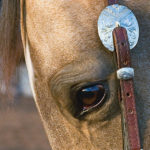These are some things to think about before, during and after you ride your horse for riders of all ages.

- If you’re going to wear a safety helmet for maximum protection, make sure you have an ASTM-SEI-approved riding helmet, not a bike or ski helmet. You can learn how to fit it correctly at www.youtube.com/chainstructor or the CHA Web site to see 10 safety videos produced by CHA ? one of which is how to fit a riding helmet.
- Wear your boots when you groom, tack and ride your horse to keep your toes safe and your foot from going through the stirrup when you ride.
- Wear pants! Riders wearing shorts can develop sores when their legs rub against the saddle leathers, and you’ll have a little extra protection if you trail ride through brush.
- Wear your gloves while you lead, groom and ride your horse to keep from getting blisters or burns. You?ll also have a better grip.
- Don?t duck under the lead rope or in front of your horse if he is in cross-ties. You can get hurt if the horse comes forward on top of you.
- Lead a bridled horse with the reins over his head in a figure-8 and not wrapped around your hand.
- Put up the irons on an English saddle when your horse is not being ridden so he cannot get a hind leg caught in them or so the stirrups do not get stuck on a fence as you and your horse pass by.
- Dismount by sliding down on your right hip, facing the head of your horse, and not by facing the saddle. You could get your shirt caught on the saddle horn or scrape your saddle leather with your belt buckle or jeans button.
- Feed your horse treats out of a bucket. Feeding by hand can get you nipped and also teaches your horse to disrespect you and try to push you for treats even when you don’t have any.
- If your horse pulls back while he is tied, don’t try to stop him! Just move away from him until the lead rope or halter breaks or until he stops pulling. Then you can untie him afterward. If you have a horse in your lesson program that pulls back, think about just wrapping the lead rope to tie him if you have your students groom and saddle as part of your lesson program.
From Certified Horsemanship Association (CHA).





